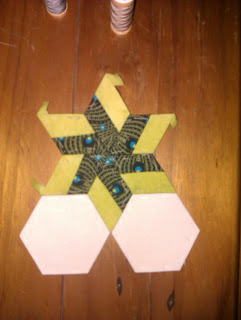Progress….Yay! After, what feels like a million, zillion hours spent hand sewing
tinny diamonds together to form stars and then sewing the two hexies to the
stars, I reached my goal of sewing - 2,516 single diamonds and 846 hexagons
together to form the star blocks. My plan is to make this quilt revisable, the star blocks have been divided in half. Yes...revisable!!!...I know I am nuts... LOL.
The top needs a total of 203 stars and 423 hexagons. Same number for the back.
The quilt will be assembled in a two row variation: Making eight strips of Row one and seven strips of Row 2 then sew row 1 and row 2 together alternately 15 times to form the main body of the quilt.
To form Row 1 I joined a star hexagon block to another star hexagon block 13 times ending with a single star at the right hand end of the row. I needed to repeating this row1 x 8 times. (Both ends of Row 1 will end with complete stars)
To form Row 2 I started by sewing a single diamond to two hexagons then sewing 13 star hexagon blocks together making sure to end the row with a single diamond with two hexagons. (Both ends of Row 2 will have single diamond). I repeated this row 2 x 7 times.
To complete the top and bottom edge of the quilt, a row of single hexagons will be joined by a pairs of diamonds.
Ta da... It is always a wonderful feeling to finish a quilt top, I do love the challenge of making this quilt reversible. It gives me another opportunity to play with different layout designs... This part of the process has taken some time auditioning the specific fabric placement of the 9 circles. It was easy to lose whole days engrossed with different layout designs.
Front done now for the back.Yay!
Happy sewing until next time
Anne




















































